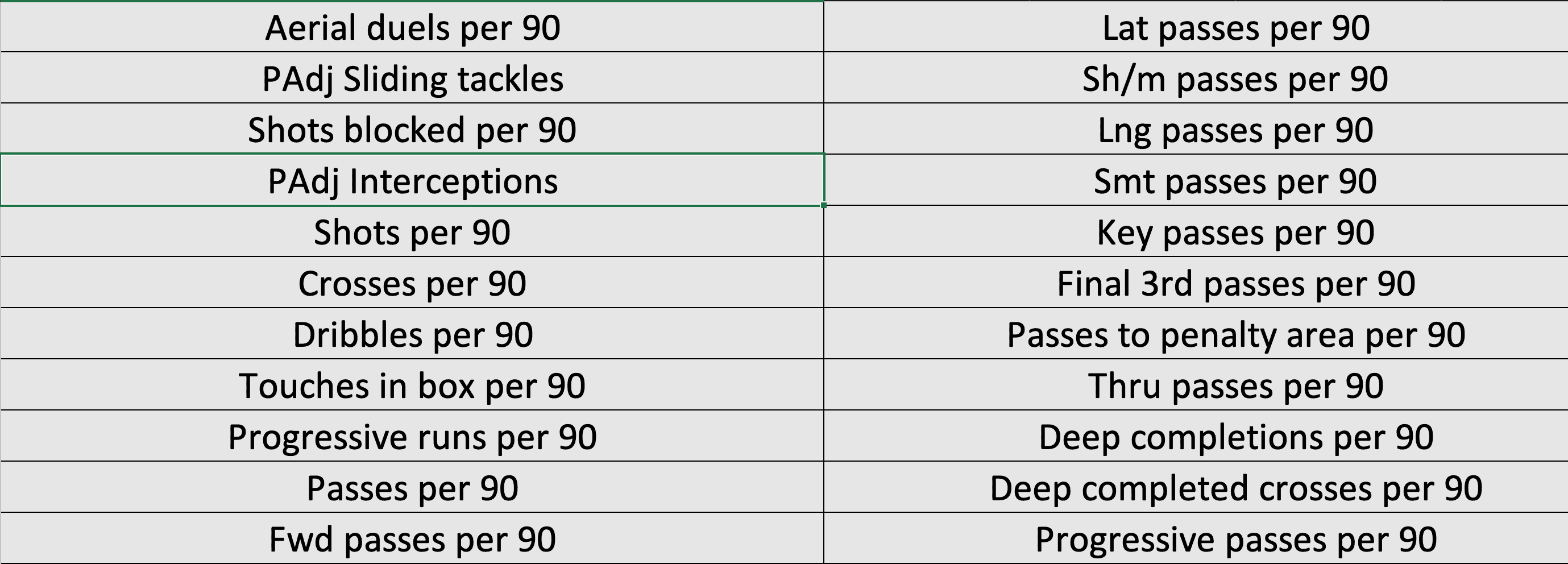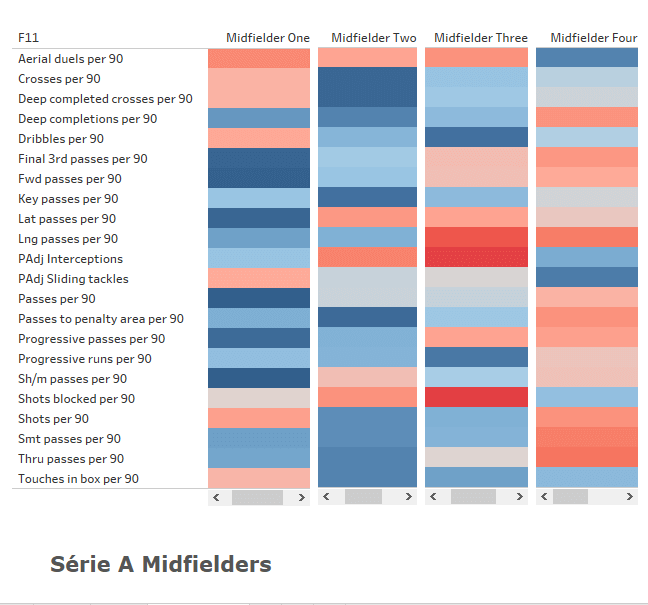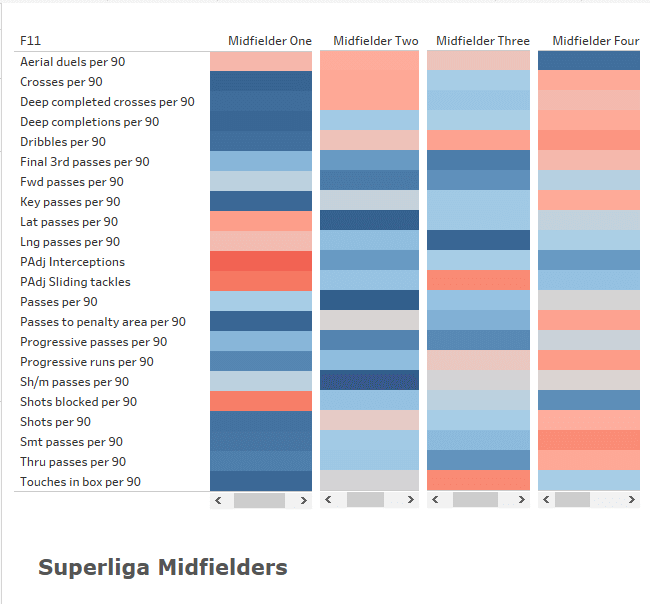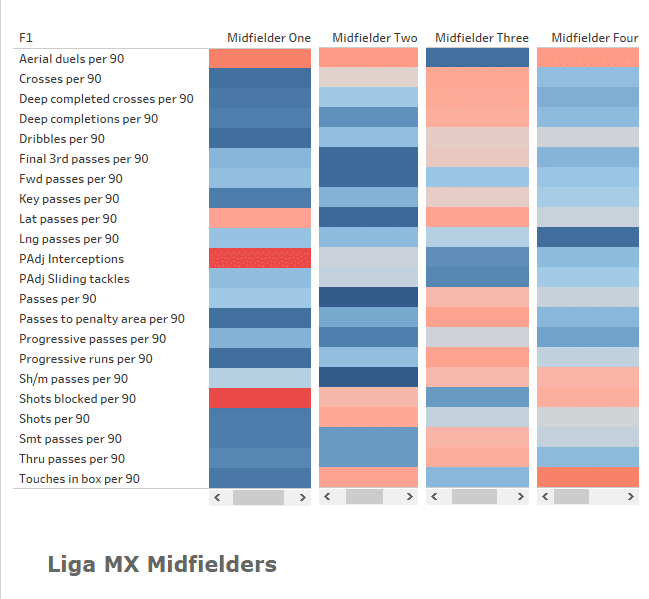Getting a lot of individual metrics to evaluate a player and assess him this way can tell a lot about his playing style and in what team he would probably best suit in. However, there are some tools that can really underpin your evaluation that you get by looking at certain statistics, and one of them is Principal Component Analysis (PCA).
Overview
This concept was first presented to me by Mark Carey, who did this analysis previously with midfielders in top five leagues and with full-backs back in 2018.
What Mark Carey writes himself:
“In broad terms, this analysis allows you to ‘zoom out’ and assess which players might be weighted towards a specific style, or which players have a broad range of styles and skills. Importantly, a PCA can help to provide a more holistic view of a player’s profile in a simplified way, rather than assessing them across 50+ individual metrics.”
This is a great analysis tool as it allows us to take a lot of statistical metrics and convert it to smaller factors, and using these factors it is easier to draw conclusions for certain players. For this analysis, I got 22 variables, with the defensive metrics being possession adjusted and all the attacking metrics valued per 90 minutes.

In this data analysis, I will look into three South American leagues – Série A, Superliga and Liga MX – and with the help of PCA examine different midfield playing styles in those leagues as well as providing short scout reports on several players that did well in those categories. In total, 179 midfielders across those leagues were taken into this analysis, with the main criteria being the minimal playing time of 900 minutes.
Série A
The first league we will analyse is the Brazilian Série A, and in the picture below you can see the results of the analysis with four main types of midfielders in this league. Let’s break down these four main types of midfielders starting from Midfielder One all the way to Midfielder Four. The bluer the particular metric, the higher influence it has on this midfield playing style.

- Midfield engine
I will be using the definitions that Mark Carey used in his analysis. This is the player that always has a lot of time on the ball, receives a lot of passes and who directs the play of his team. In this case, not only these midfielders receive a lot of passes and get the most amount of passes off their feet, but they are also oftentimes the most responsible for ball progression through their passes. You can see that despite having a high volume of short passes and lateral passes, these players also excel in passes to the final third, passes to the penalty area, etc. Let’s look at the best examples of these players in Série A.
The first player of this category is 34-year-old Maicon from Grêmio, who is playing as the left defensive or central midfielder. He completes 100,7 passes per game with 93,76% accuracy, which makes him the clear leader in this aspect. He is also leading in the following categories: final third passes(17,83 per game), progressive passes(14,69 per game) and short passes attempted(94,16 per game). He is the controlling midfielder of the Imortal Tricolor, being the best example for these type of midfielder with a lot of short passes, distributing the ball to the desired areas.
The next player on the list is Bruno Guimarães, who left Athletico-PR to join Olympique Lyonnais in the winter transfer window due to his brilliant performances. He completes a lot of long passes, 6,43 per game, along with 3,45 interceptions and 2,19 progressive runs per game. He is superb ball-carrier, long ball passer and has good defensive abilities.
The São Paulo’s Dani Alves, who was often playing as right central midfielder as well as in his natural right-back position, proves his worth even when being in closing stages of his career. Former Barcelona player makes 3,77 dribbles per game, 2,38 crosses per game and 0,25 xA per 90 he still plays his best football for the Tricolor.
The 35-year-old Carlos Sánchez was one of the best players in Série A in 2019 with 0,41 goals and 0,26 assists per game, he proved to be a great goalscorer for the second-placed Santos. However, he also contributed to his team with his passing, getting 3,29 crosses, 4,84 long passes, and 8,65 progressive passes per game.
There are a lot of other players in this category, for example, Fluminense’s attacking midfielder Nenê and Bahia’s central midfielder Daniel, who also have had great seasons, but it would be too big of an article if I were to include all those players.
- Direct play
The midfielder Two category is the group of midfielders that are constantly endangering the opposition penalty box with passes, shots and crosses and they also spend a lot of time in the box themselves.
There are two players that stand out in this category: Patrick and Evandro.
Patrick has the highest amount of touches in the box from all the midfielders with 2,33 per game, along with 6,01 progressive passes and 3,41 interceptions being his stand out numbers. The 27-year-old plays as a left attacking or central midfielder and gets 2,18 crosses per game.
Evandro is another central midfielder from Santos, but, unlike aforementioned Carlos Sánchez, he is more balanced out central midfielder, getting a lot of done in the defensive end and helping out in the attack as well. Defensively, he tackles 1,85 times per game along with 3,57 interceptions, and he also plays 5,05 progressive passes and has 1,84 touches in the box per game.
- Attacking threat
In the third category of the midfield playing styles, we have players that make the most out of their dribbling abilities and thus are really good in progressing the ball forward with their runs.
Here we have two runaway leaders in Patrick, whose style of play combines the previous category and this one – he makes 7,36 dribbles per game and 2,38 progressive runs, and in Mateus Vital – the 22-year-old left central midfielder who also played as a left winger last season – with 6,12 dribbles and 3,02 progressive runs per game. These players can single-handedly create havoc in opposition defensive lines with their penetrating runs and skills from midfield.
- Defensive awareness
In the last category, we have players that stand out defensively, making a lot of tackles, interceptions and being formidable in aerial battles. These are the players that are the best in Série A defensively:
- Willian Arão from Flamengo with 5,07 aerial duels and 7,82 interceptions. He does his job brilliantly in Jorge Jesus’s victorious side.
- Fabinho, who has a similar defensive output as Arão, with 5,28 aerial duels and 6,2 interceptions.
- Alison – another midfielder from Santos, who has 8,94 interceptions, 1,88 aerial duels and 2,12 tackles per 90 minutes.
- Very similar player to Alison in terms of output is 35-year-old Ralf with 8,95 interceptions and 2,9 aerial duels per game.
All in all, a lot of players that I listed above have had a spectacular season last year, and this analysis helps to better identify the differences in playing styles or to faster connect the dots and see what players do certain things well. Also, it is easier to spot strong sides in team’s squad – for example, the Santos midfield have players with vastly different playing styles: Carlos Sánchez, Evandro and Alison, all having different roles on the pitch.
In the next section of this data analysis, we will examine different playing styles in Argentinian Superliga.
Superliga
Below you can see the chart for the main four types of midfield playing styles in Superliga. It’s easy to spot some differences with Série A right away: bigger emphasis on crosses and long balls, plus I believe there is a bigger separation between styles in contrast to what we’ve seen in the previous section, where the first three had a lot of similarities and players in several categories(like Carlos Sánchez).

- Creative force
This is a very similar style to Midfield Engine, however, this style requires even more ball-progressing passes and less quick passing combinations. This is the type of midfielder that constantly tries to create goalscoring opportunities with different tools: crosses, forward passes, shots. Superliga is much more vertically-oriented than Série A from passing point of view, so there are a lot of players that play progressive forward passes.
The first player that represents this style really well is River Plate’s Ignacio Fernández, who has great balanced numbers in all the necessary metrics, with 12,1 progressive passes, 6,75 dribbles, 2,81 crosses and 4,54 passes to the penalty area per 90 minutes. He is essential for Marcelo Gallardo’s tactics and his presence on the pitch really makes the difference for Los millonarios.
Marcelino Moreno is another player that makes the difference for his club Atlético Lanús, with 9,66 dribbles, 2,74 crosses, 6,4 progressive passes per 90 minutes.
Tomás Pochettino, who plays for Club Atlético Talleres, is one of the best chance creators in Superliga, with 9,58 progressive passes, 2,15 crosses and 4,39 dribbles.
The 21-year-old José Paradela is another Argentinian talent, who is playing for Club de Gimnasia and his coach Diego Maradona has already advised his former Serie A side Napoli to go for a transfer of the midfielder. He is a skilful player who is most responsible for creating chances in his team, making 8,21 dribbles and 6,35 progressive passes per 90 minutes.
Another River Plate midfielder Nicolás De La Cruz, who is linked to several European clubs and can follow Exequiel Palacios’s footsteps – 5,72 dribbles, 8,64 progressive passes, 3,05 progressive runs and 2,54 shots per game – he is the most balanced out player in this category together with his teammate Fernández. He works hard defensively too – 2,99 aerial duels and 3,98 interceptions prove he is great on the defensive end.
- Midfield Engine
This category of midfielders slightly differs from what we saw in the previous section. These midfielders are getting a lot of time on the ball, but, in contrast to midfielders in Série A, they play fewer risky passes and more short and/or lateral passes, that keep possession and switch the direction of attacks.
The stand out player in Midfield Engine category are Marcelo Díaz from Boca Juniors, who plays 91,2% of his passes in short distances, 5,5 long passes and 9,83 progressive passes, plus he makes 8,91 interceptions per 90 minutes, proving to be a valuable player to have for the Argentinian side.
Also, other two players to feature are Enzo Pérez of River Plate with 94,3% of his passes being short passes, along with 10,29 interceptions, 4,32 long passes, and 11,91 progressive passes on average, and another one is former Real Madrid‘s and Boca Juniors’ defensive midfielder Fernando Gago, who is currently playing for Gabriel Heinze’s Velez Sarsfield. He contributes a lot defensively, with 4,98 aerial duels, 3,32 tackles and 7,96 interceptions, but more importantly, he makes 7,67 long passes, 11,83 progressive passes, and 87,9% of the time he plays short passes, and from these stats, you can see his huge involvement and influence on the team’s build-up.
- Direct play
In this category, we have players that progress the ball forward quite a lot, with a big emphasis on long balls in general and on passes into the final third. Direct play involves some variables from the previous two categories, so here is a big intersection of players. The best names in this category are Fernando Gago, Enzo Pérez and Ignacio Fernández, plus we have Jesús Soraire from Arsenal Fútbol, who makes 12,37 passes into the final third, 17,65 forward passes, 7,35 long passes, and 11,59 progressive passes per 90 minutes. There are a lot of midfielders in this category with similar output in these metrics, but I highlighted the four highest-performing ones.
- Defensive awareness
The last category of midfield playing styles in Argentina is a very interesting one, and it contains players with a high volume of aerial duels, in contrast to what we’ve seen in Série A, where the biggest factors defensively were interceptions and tackles. As you’ve probably noticed, in this league there is a bigger focus on playing long, so defensive midfielders have to have great aerial ability to counter it.
The player that caught my eye is Club Estudiantes’s Enzo Kalinski, who 8,29 interceptions per game and has on average 7,12 aerial duels, the second in the league in that regard. Then we have such players as Marcelo Estigarribia, Jesús Méndez, Sergio Vittor and Juan Andrada, who all have similar levels of defensive output to Kalinski.
Unlike some other categories, this playing style requires different, more defensively-minded skillset, so there is not much of an overlap with other styles, and I found only one player that is showing good numbers in several categories including this one – Fernando Gago.
Liga MX
The Mexican league is the last league that we are going to cover, and it has the least amount of midfielders which met our requirements(to be exact, only 45 of them).
You can straight away spot the similarities between the Liga MX and Superliga midfield playing styles, and we will go through the same categories of midfielders as in the previous section of analysis. Liga MX’s playing style is a lot look-alike to Superliga than Série A, with the latter being the most autonomous out of all of them.

- Creative force
Just in the Superliga, the first category is the group of players that progress the ball the most with their dribbles, crosses and so on.
In terms of output of dribbles and crosses, Pachuca’s 36-year-old veteran Rubens Sambueza is the runaway leader, with 3,31 crosses and 5,95 dribbles per 90 minutes.
The other two players with good numbers are Dieter Villalpando of Guadalajara with 3,26 dribbles, 3,46 passes to the penalty area and 1,88 shots per game, and Luis Montes from Club León with 4,28 dribbles, 3,25 passes to the penalty area, and 1,5 shots per game.
The rest of the players are congested in terms of output, and there is no point more of the
- Midfield engine
In the second category, we have midfielders that receive the ball a lot and play a bunch of different length passes.
On the top, we have Villalpando and Sambueza, together with Rodrigo Millar, who plays 93,8% of his passes short along with making 11,9 progressive passes per game. In the leaders we also have Rafael Carioca, who is regularly featuring for his club Tigres UANL, playing 8,08 progressive passes and 4,83 long passes per game. Very similar players output-wise are Pizarro, Rocha, Montes and Miranda.
- Defensive awareness
This is an almost identical category to Superliga in terms of metrics used, with a heavy focus on the defensive end.
The stand out player here is Jesús Molina, complementing his teammate Villalpondo, who bears more offensive responsibilities. The 32-year-old makes 8,28 interceptions and participates in 5,54 aerial duels per 90 minutes.
Other players have slightly fewer numbers than Molina, but there are a lot of players with this style of play: Aquino, Esquivel and Ríos as examples.
- Direct play
Here we have a bigger focus on playing long and progressing the ball this way, and outside of the players that I mentioned before that fall into this category too, like Montes and Villalpando, the 22-year-old Jorge Sánchez also shines, with 5,63 long passes and 7,05 progressive passes in general per 90 minutes.
League comparison
After going through all the three leagues and finding some interesting players representing each playing style it becomes much easier to find commonalities and differences between the three main leagues in South American football.
Obviously, the general league playing styles, that haven’t been changing in their cores for a long time, influence the playing styles of individual teams and players. In my opinion, midfielders are the players that give the best reflection of league’s playing style, what it demands from the player, physically and mentally.
Many people that don’t watch much South American football tend to think that playing styles across these leagues are similar and when evaluating players from the statistical perspective they don’t take into account that Série A, Superliga and Liga MX have quite a lot of differences.
From the direct comparison, the contrast between the Série A’s style of play and the playing styles of both Superliga and Liga MX are drastically different. The attacking play in Série A is much slower, with fewer turnovers and thus with longer periods of possession. Whereas Superliga and Liga MX’s playing styles favour more high-intensity approach, with a lot of possession phase changes and more direct play in general. This is the best illustrated in amount of progressive passes and long balls being played in those two leagues, which are both higher than in the Série A, and this style provokes more interceptions and more emphasis on aerial duels as a result. So, just comparing the volume of defensive actions, for example, for a centre-backs from Brazil and Argentina won’t work. It’s always important to take into account that all the statistical metrics are subjective and dependant on many factors, and I believe in case of these three leagues it becomes triple as important.
Conclusion
Hopefully, this analysis brought you some awareness in the midfield playing styles in the biggest three leagues in South America, and that you also found some interesting names to watch out for in the future. There are a lot of great players with different strengths and weaknesses, and it was cool to go through some of them in this data analysis.





Comments